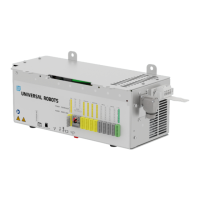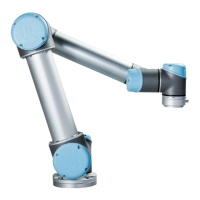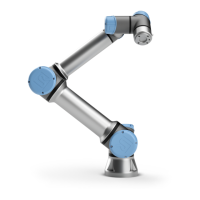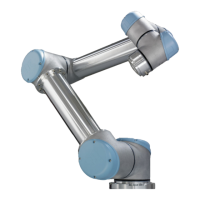Dimensionin
g the Stand
The magnitude of the loads depends on robot model, program and multiple other factors.
Dimensioning of the stand shall account for the loads that the robot arm generates during
normal uninterrupted operation and during category 0, 1 and 2 stopping motion.
During stopping motion, the joints are allowed to exceed the maximum nominal operating
torque. The load during stopping motion is independent of the stop category type.
The values stated in the following tables are maximum nominal loads in worst-case
movements multiplied with a safety factor of 2.5. The actual loads will not exceed these
values.
Robot Model Mz [Nm] Fz[N] Mxy[Nm] Fxy [N]
UR30 2220 3520 2700 2370
Maximum joint torques during category 0, 1 and 2 stops.
Robot Model Mz [Nm] Fz[N] Mxy[Nm] Fxy [N]
UR30 1850 2690 1890 2080
Maximum joint torques during normal operation.
The normal operating loads can generally be reduced by lowering the acceleration limits of
the joints. Actual operating loads are dependent on the application and robot program. You
can use URSim to evaluate the expected loads in your specific application.
Safety
margin
s
You can incorporate added safety margins, factoring in the following design considerations:
•
Static stiffness: A stand that is not sufficiently stiff will deflect during robot motion, resulting
in the robot arm not hitting the intended waypoint or path. Lack of static stiffness can also
result in a poor freedrive teaching experience or protective stops.
•
Dynamic stiffness: If the eigenfrequency of the stand matches the movement frequency of
the robot arm, the entire system can resonate, creating the impression that the robot arm is
vibrating. Lack of dynamic stiffness can also result in protective stops. The stand should
have a minimum resonance frequency of 45 Hz.
•
Fatigue: The stand shall be dimensioned to match the expected operating lifetime and load
cycles of the complete system.
CAUTION
•
If the robot is mounted on an external axis, the accelerations of this axis
must not be too high. You can let the robot software compensate for the
acceleration of external axes by using the script command set_base_
acceleration()
•
High accelerations can cause the robot to make safety stops.
WARNING
•
Potential for tip-over Hazards.
•
The robot arm's operational loads can cause movable platforms, such as
tables or mobile robots, to tip over, resulting in possible accidents.
•
Prioritize safety by implementing adequate measures to prevent the
tipping of movable platforms at all times.
User Manual 42 UR30
6.Assembly and Mounting
Copyright © 2009–2024 by UniversalRobotsA/S. All rights reserved.

